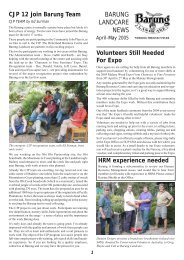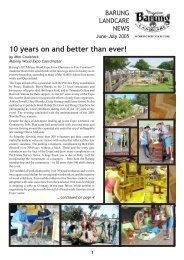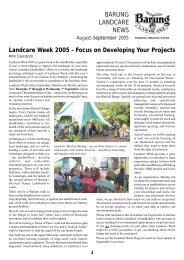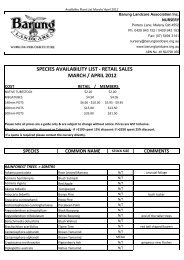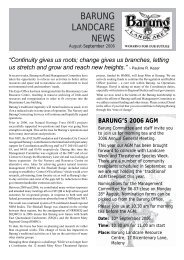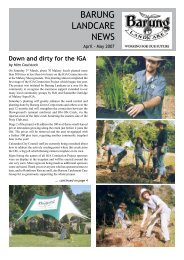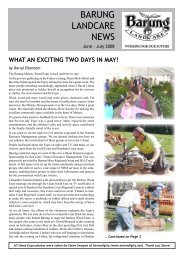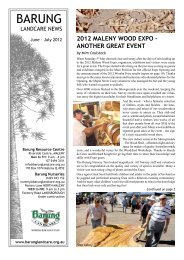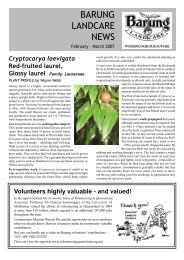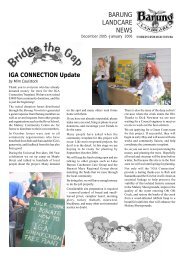Jun/Jul 2010 - Barung Landcare
Jun/Jul 2010 - Barung Landcare
Jun/Jul 2010 - Barung Landcare
You also want an ePaper? Increase the reach of your titles
YUMPU automatically turns print PDFs into web optimized ePapers that Google loves.
WHEN HOME IS A HOLLOW<br />
WIILDLIFE WANDERINGS by Susie Duncan<br />
As humans, we all want a secure and comfortable home to live<br />
in. It’s no different for wildlife.<br />
In Australia one of the most popular fauna apartment blocks is a<br />
large tree with a hollow trunk or limbs. In south-eastern Australia,<br />
17% of bird species, 42% of mammals and 28% of reptiles use tree<br />
hollows for shelter and/or breeding. This includes birds such as<br />
kingfishers, parrots and owls; mammals such as possums, gliders<br />
and bats; and a range of reptiles and frogs. Some native fish also<br />
use submerged hollow logs for shelter and egg attachment.<br />
Animals are selective about what constitutes a good home and this<br />
varies between species. Size, aspect, insulation and humidity can<br />
all influence choices. Many species will seek a hollow with the<br />
smallest possible entrance, just big enough for them to squeeze<br />
in but hopefully too small for predators such as goannas. And<br />
competition is intense. I once saw a Common Brushtail Possum<br />
trying to appropriate a hollow from a Galah which was presumably<br />
brooding eggs. Some mammals use a number of hollows to<br />
extend their foraging territory or to evade predators.<br />
In Australia, eucalypts are particularly prone to hollow formation.<br />
They tend to shed lower branches as they grow and are subject to<br />
damage from storms, fire, lightning strikes and insect attack. At<br />
damaged sites the outer wood remains solid but the interior rots<br />
where water and fungi have access, and so hollows form.<br />
This process starts as the tree ages, with smaller hollows becoming<br />
available around 100 years of age. Medium-sized hollows used<br />
by possums and parrots may take 150-200 years to form. And the<br />
very big hollows used by the large owls and cockatoos form in<br />
even older trees. Hollows in fallen trees and branches also provide<br />
wildlife with residential or quick escape options.<br />
We once monitored a large dead standing tree in a heavily logged<br />
forest in northern Victoria. The tree had escaped harvest because<br />
of its crooked form but had been ringbarked to ensure that it didn’t<br />
compete with regrowth trees. As we quietly watched the silhouetted<br />
tree on dusk, a Brush-tailed Phascogale family emerged: one<br />
adult female and three young. These are very cute marsupials<br />
about the size of a kitten, with bottle-brush type tails. They disappeared<br />
into the night and we waited until it was almost totally<br />
dark. At this stage a family of Sugar Gliders emerged one by one<br />
and glided off into the dark forest. Over time this same tree was<br />
home to a Common Brush-tail Possum, a family of Antechinus<br />
and a hive of European Bees. Which just goes to show the significance<br />
of hollows in the Australian landscape.<br />
Dead standing trees are also well utilised by colonies of micro-bats<br />
(the very small bats you see flitting around against the dusk or<br />
dawn sky, not the slow-flapping fruit bats). They are very mobile<br />
so they will happily roost in a dead tree way out in a paddock and<br />
then catch flying insects over the paddock as well as in forest some<br />
distance away. In comparison a Sugar Glider can only glide about<br />
50 m so isolated dead trees don’t make great homes for gliders.<br />
The micro-bats do a great service for agriculture, consuming up<br />
to half their body weight in insects per night.<br />
Hollows are critical to the conservation of Australian wildlife so<br />
think carefully about what you might be harvesting for woodturning<br />
or firewood; it might just be someone’s home.<br />
This long dead forest giant provides hollows for wildlife,<br />
perches for black and sulphur-crested cockatoos, wood<br />
ducks and satin and regent bower birds among others,<br />
and some 12 metres from the ground is hosting a 40-<br />
year-old small-leaved fig, a lomandra, a cordyline and<br />
other shrubs, all of which provide further sustenance for<br />
wildlife.<br />
[Photo by Eve Witney]<br />
5<br />
WILDLIFE WALKS<br />
with SUSIE DUNCAN<br />
Monday 21 <strong>Jun</strong>e<br />
Mothar Mountain, near Gympie<br />
3.2 km walk on track. Moderate to very steep grades.<br />
Rock pools, rainforest and eucalypt forest.<br />
Friday 16 <strong>Jul</strong>y<br />
Maroochy Wetlands &<br />
Maroochy River Conservation Park<br />
6.4 km walk on tracks. Easy grades.<br />
Paperbark and eucalypt forests, mangroves & saltmarsh.<br />
Friday 27 August<br />
Bellthorpe Forest<br />
Approx. 4 km on tracks. Moderate to steep grades.<br />
Old-growth eucalypt forest, rainforest and creek cascades.<br />
This walk is part of the Festival of Walks.<br />
For all walks:<br />
•<br />
•<br />
•<br />
Please book at <strong>Barung</strong> on 5494 3151. No fee.<br />
Park in the public carpark behind Maleny IGA and meet<br />
at the <strong>Barung</strong> Office (next to Australia Post) at 8.45 am<br />
to car pool; expect to return to <strong>Barung</strong> by 4 pm.<br />
Bring water, lunch, boots, hat, sunscreen, insect repellent,<br />
binoculars, and togs if you wish to swim.



